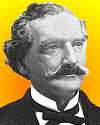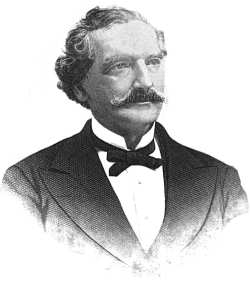 (source)
(source)
|
Gardner Quincy Colton
(7 Feb 1814 - 9 Aug 1898)
American lecturer who was the first to administer nitrous oxide as an anaesthetic. He gave scientific lectures, and his exhibited nitrous oxide gas. Later, he started The Colton Dental Association of New York, where dentists successfully used it as an anaesthetic.
|
Early Electric Railways
From The Electrical Review (1893)
[This article describes briefly Gardner Quincy Colton's early involvement in his invention of a model railway using a metallic track in the circuit to supply electricity to the locomotive's motor. Certainly he was a man of diverse interests, because his later main claim to fame was popularizing nitrous oxide (“laughing gas”) as a dental anaesthetic. He was also a Shakesperean scholar.]
We have it on the authority of the New York Electrical Engineer, that the first to use the metallic track, or rails, as the supply circuit in an electric railway, at any rate in America, was Mr. Gardner Quincy Colton, who exhibited a model railway in 1847. In the earlier part of his career Mr. Colton was a peripatetic philosopher, and the model electric railway was part of his stock-in-trade. Similar models, but on the old system, were made by Mr. Davenport and were exhibited in New York, probably in the year 1837. Ten years later Mr. Moses G. Farmer designed his electric locomotive; and in 1851 Mr. Thomas Hall was the possessor of a model built on the Colton system. Colton was in the field four years before Hall. His locomotive was built by a model maker whose name was Lilly. It was quite a small locomotive, being only 14 inches long and 5 inches wide, and was propelled by a "vibrating" motor supplied with current from four cells, via the rails. Behind were four cars of about the same size as the locomotive. The track consisted of a wooden ring, or felly, about 8 feet in diameter. The two rails were formed by thin bands of iron, fastened, one upon the exterior ring of the felly, and one upon the interior, both being bridged by the locomotive, the upper edges projecting far enough above the wood to receive the car wheels. The model, was therefore a precursor of that which was exhibited in the eighteen-eighties by Profs. Ayrton & Perry, except, of course, that the latter had a far more perfect scheme of stopping, starting, and blocking on the line of route, as well as an indicator map to show the exact position of a train, on any section, at the signal box. Mr. Gardner Quincy Colton was born at Vermont in 1814, and now, at the advanced age of 79, he practices daily the profession of dentistry. The Electrical Engineer, New York, describes him as “the youngest of 12 children,” and adds, curiously enough, “some of whom have attained a greater age than himself.” His philosophy in his travelling days seems to have been somewhat mixed with art and medicine. Art was represented by a picture, the largest in America at the time, called the “Court of Death.” It was greatly due to this that he gained a living. In addition, he lectured upon the properties of laughing gas, and, in dental circles in America, he appears to have gained notoriety owing to his partiality for this mirth-provoking anaesthetic; and, strangely* enough, he attributes his continued good health to the same lively cause. He says, “I am inclined to think I shall owe ten years of my life to the good effects of the gas, for I inhale about 20 gallons every day in showing patients how to commence. The gas is just like air, only containing a little more oxygen. Oxygen is what gives life and vitality to the blood. We live on oxygen.” No doubt hilarity prolongeth life, but before giving the above method a trial we hesitate. Fiat experimentum in corpore vili.*
* [Let experiment be made on a worthless body.]
- Science Quotes by Gardner Quincy Colton.
- 7 Feb - short biography, births, deaths and events on date of Colton's birth.
- Gardner Quincy Colton - In Memoriam that makes mention of Colton's other interests, from Items of Interest (1898).
- Gardner Quincy Colton and Nitrous Oxide - a more detailed article on Colton's work with nitrous oxide, from History of New York City (1884).
- The History of Surgical Anesthesia, by Thomas E Keys. - book suggestion.





